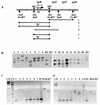Differential spectrum of mutations that activate the Escherichia coli bgl operon in an rpoS genetic background
- PMID: 12081976
- PMCID: PMC135163
- DOI: 10.1128/JB.184.14.4033-4038.2002
Differential spectrum of mutations that activate the Escherichia coli bgl operon in an rpoS genetic background
Abstract
The bgl promoter is silent in wild-type Escherichia coli under standard laboratory conditions, and as a result, cells exhibit a beta-glucoside-negative (Bgl-) phenotype. Silencing is brought about by negative elements that flank the promoter and include DNA structural elements and sequences that interact with the nucleoid-associated protein H-NS. Mutations that confer a Bgl+ phenotype arise spontaneously at a detectable frequency. Transposition of DNA insertion elements within the regulatory locus, bglR, constitutes the major class of activating mutations identified in laboratory cultures. The rpoS-encoded sigmaS, the stationary-phase sigma factor, is involved in both physiological as well as genetic changes that occur in the cell under stationary-state conditions. In an attempt to see if the rpoS status of the cell influences the nature of the mutations that activate the bgl promoter, we analyzed spontaneously arising Bgl+ mutants in rpoS+ and rpoS genetic backgrounds. We show that the spectrum of activating mutations in rpoS cells is different from that in rpoS+ cells. Unlike rpoS+ cells, where insertions in bglR are the predominant activating mutations, mutations in hns make up the majority in rpoS cells. The physiological significance of these differences is discussed in the context of survival of natural populations of E. coli.
Figures




Similar articles
-
rpoS function is essential for bgl silencing caused by C-terminally truncated H-NS in Escherichia coli.J Bacteriol. 1999 Oct;181(20):6278-83. doi: 10.1128/JB.181.20.6278-6283.1999. J Bacteriol. 1999. PMID: 10515915 Free PMC article.
-
Silencing of the Escherichia coli bgl operon by RpoS requires Crl.Microbiology (Reading). 2002 Aug;148(Pt 8):2573-2578. doi: 10.1099/00221287-148-8-2573. Microbiology (Reading). 2002. PMID: 12177351
-
Independent regulation of H-NS-mediated silencing of the bgl operon at two levels: upstream by BglJ and LeuO and downstream by DnaKJ.Microbiology (Reading). 2005 Oct;151(Pt 10):3349-3359. doi: 10.1099/mic.0.28080-0. Microbiology (Reading). 2005. PMID: 16207917
-
Regulation of gene expression: cryptic β-glucoside (bgl) operon of Escherichia coli as a paradigm.Braz J Microbiol. 2015 Mar 4;45(4):1139-44. doi: 10.1590/s1517-83822014000400003. eCollection 2014. Braz J Microbiol. 2015. PMID: 25763016 Free PMC article. Review.
-
Control of rpoS transcription in Escherichia coli and Pseudomonas: why so different?Mol Microbiol. 2003 Jul;49(1):1-9. doi: 10.1046/j.1365-2958.2003.03547.x. Mol Microbiol. 2003. PMID: 12823806 Review.
Cited by
-
Involvement of the global regulator H-NS in the survival of Escherichia coli in stationary phase.J Bacteriol. 2012 Oct;194(19):5285-93. doi: 10.1128/JB.00840-12. Epub 2012 Jul 27. J Bacteriol. 2012. PMID: 22843842 Free PMC article.
-
Competition between transposable elements and mutator genes in bacteria.Mol Biol Evol. 2012 Oct;29(10):3153-9. doi: 10.1093/molbev/mss122. Epub 2012 Apr 23. Mol Biol Evol. 2012. PMID: 22527906 Free PMC article.
-
Functional analysis of the genes encoding diaminopropionate ammonia lyase in Escherichia coli and Salmonella enterica serovar Typhimurium.J Bacteriol. 2012 Oct;194(20):5604-12. doi: 10.1128/JB.01362-12. Epub 2012 Aug 17. J Bacteriol. 2012. PMID: 22904288 Free PMC article.
-
Transposon-mediated adaptive and directed mutations and their potential evolutionary benefits.J Mol Microbiol Biotechnol. 2011;21(1-2):59-70. doi: 10.1159/000333108. Epub 2012 Jan 13. J Mol Microbiol Biotechnol. 2011. PMID: 22248543 Free PMC article. Review.
-
Evolution of aromatic β-glucoside utilization by successive mutational steps in Escherichia coli.J Bacteriol. 2015 Feb 15;197(4):710-6. doi: 10.1128/JB.02185-14. Epub 2014 Dec 1. J Bacteriol. 2015. PMID: 25448815 Free PMC article.
References
-
- Amster-Choder, O., and A. Wright. 1992. Modulation of the dimerization of an antiterminator protein by phosphorylation. Science 257:1395-1398. - PubMed
-
- Caramel, A., and K. Schnetz. 1998. Lac and lambda repressors relieve silencing of the Escherichia coli bgl promoter: activation by alteration of a repressing nucleoprotein complex. J. Mol. Biol. 284:875-883. - PubMed
-
- Case, C. C., S. M. Roels, J. E. Gonzalez, E. L. Simons, and R. W. Simons. 1988. Analysis of the promoters and transcripts involved in IS10 anti-sense RNA control. Gene 72:219-236. - PubMed
-
- Di Nardo, S., K. A. Voelkel, R. Sternglanz, A. E. Reynolds, and A. Wright. 1982. Escherichia coli DNA topoisomerase I mutants have compensatory mutations in the DNA gyrase genes. Cell 31:43-51. - PubMed
Publication types
MeSH terms
Substances
LinkOut - more resources
Full Text Sources
Molecular Biology Databases
Miscellaneous

